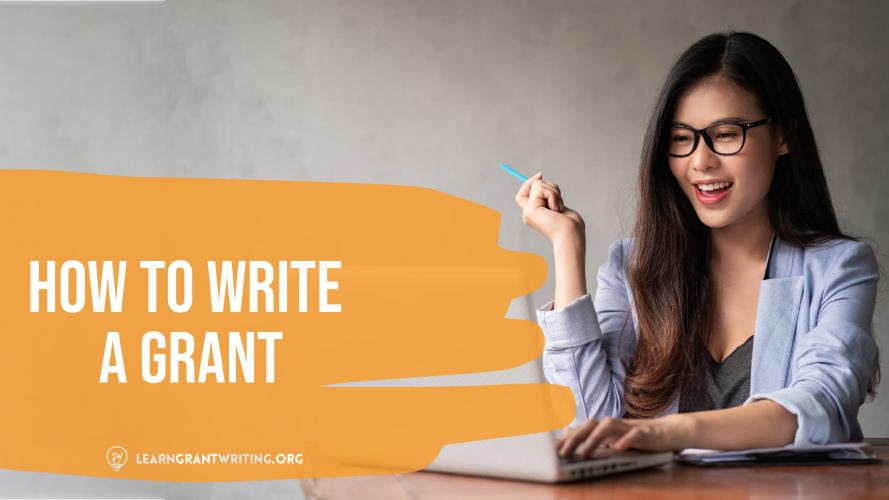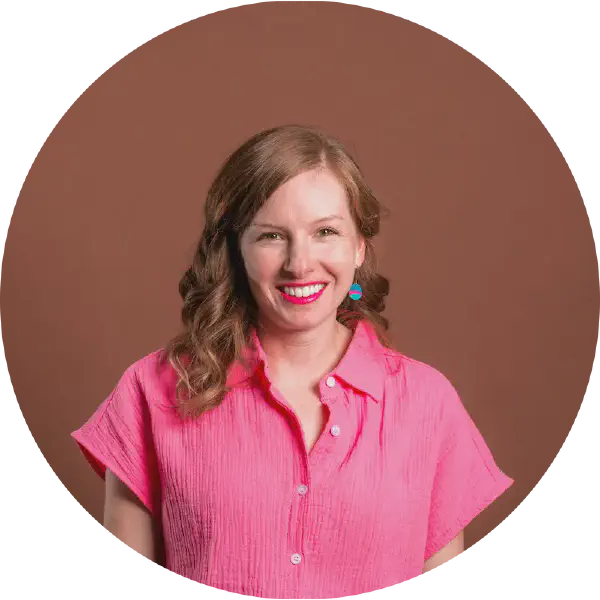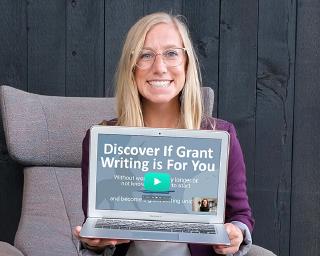You’ve been asked to write a grant proposal for your nonprofit. Or you’re looking for a new way to grow your skills and earn some extra cash while doing good. You’re writing a proposal as a freelance grant writer. What comes next?
Grant writing is a specialized skill, and real money is on the line for important causes. While writing a grant for the first time can feel nerve-wracking, grant writing is a very learnable skill. Master it, and you can unlock tons of support for organizations. You can also build a more fulfilling career.
The trick to success is following consistent processes to stay on schedule and produce your best work. This guide breaks down our very best advice on how to write a grant and win more funding. We’ve also included bonus tips to level up your proposal writing.
Here’s what we’ll cover:
- How to Write a Grant Proposal: Video Overview
- Anatomy of a Grant Proposal
- How to Write a Grant in 7 Steps
- How We Can Help
How to Write a Grant Proposal: Video Overview
Let’s kick things off with a little context:
What’s a Grant?
A grant is a financial award to support a person, organization, project, or program. It is intended to achieve a specific goal or purpose. In most cases, a grant is awarded to a nonprofit organization from a foundation, corporation, or government agency to fund a specific project or program.
What's Grant Writing?
Grant writing is the act of preparing an application to receive funding for a project or organization through a grant. The magic of grants is that the money awarded does not need to be paid back, which makes them such valuable sources of funding.
To learn more about how grants work and who’s eligible for them, head over to our longer guide to grant writing basics!
Grant writing is like baking cake.You have a recipe to follow to get it just right. Some recipes are more complex than others—a small local grant is your basic chocolate cake, while a big federal grant is a three-tiered wedding cake.
Whatever you’re baking, there are key ingredients coming together in specific steps. When you learn the fundamentals, you can adapt to any recipe (or grant proposal) thrown your way.
🎂 For the visual learners among us, follow along as we bake up a grant proposal! 🎂
Anatomy of a Grant Proposal
Before jumping right into your first grant writing project, it’s helpful to understand the different elements that grant applications often ask for. This will give you a clearer idea of what to expect and what information you’ll need to gather for your proposal. Let’s take a look:

Most grant proposals include these main sections:
- Introduction or abstract. What can grant makers expect from your proposal? (Pro tip—write your abstract last so that it’s as accurate and reflective of your story as possible!)
- Organizational background. Who are you writing the grant for? What is the organization’s history?
- Statement of need. Why are you proposing a project or program? What needs will it address in your community? Do you have hard numbers to back it up?
- Project description. What is the project or program you’re proposing?
- Methodology. How will you implement your new project? What will the steps and timeline look like?
- Goals and objectives. What are the specific, measurable goals for your project? How do they connect back to the statement of need?
- Budget. How much will it cost to implement your project? How much of that funding will come from different sources, including this grant?
- Evaluation plan. How will you measure your progress and the impact of your project?
- Sustainability plan. How will you sustain the new project or program after the grant funding ends?
In addition, many grants require further documentation like:
- A resolution. Is your whole organization on board with the project and ready to comply with the funder’s requirements if awarded the grant?
- Risk assessments. What are the risks and challenges that may impact the successful implementation of your project?
- Partnerships and collaborations. Are other organizations, sponsors, and/or major donors helping to fund or implement your project?
- Letters of support. Can constituents and peer organizations back up your organization’s ability to get things done?
- Appendices, data, and research. Do you have additional research to back up your statement of need and projected impact?
- Other supporting documents, like resumes of key staff members and a copy of your IRS 501(c)(3) Letter of Determination.
Note that different grants can have wildly different requirements depending on the context and funder. Grant applications might also have different names for these elements, so it’s important to very closely read and understand their requirements—see Step 1 below!
Free Grant Writing Class
Learn the 7-steps to write a winning grant application and amplify the impact you have on your community.
Access Free Class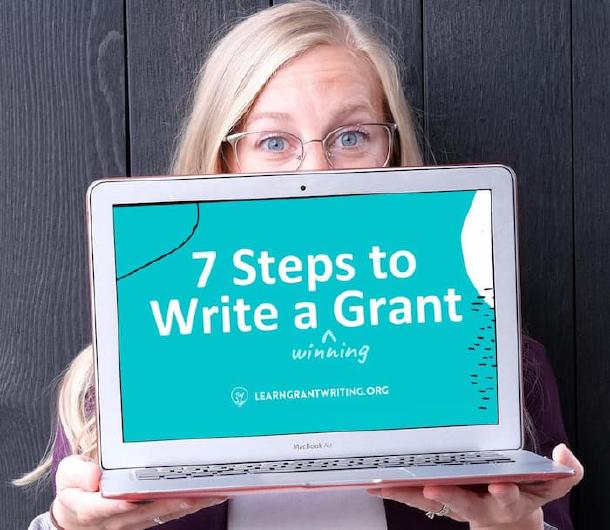
The Nitty-Gritty: How to Write a Grant in 7 Steps
We’ve covered all the parts of a grant proposal that you might encounter. Now, let’s get into how you actually write the darn thing.
At Learn Grant Writing, we follow a tried-and-true 7-step approach to writing winning grants.

Step 1: Follow Your North Star ⭐ (AKA the Funding Guidelines).
Funding guidelines are instructions from the funder on how to apply for a grant. They’ll also include information about eligibility, what the narrative requires, attachments, and much more.
These guidelines are not like the Ikea instructions you didn’t read or the airplane safety card you ignored. Nope, these funding guidelines are like having the recipe for your great-grandmother’s famous family spaghetti sauce, and if you diverge at all you will not quite get it right.
For that reason, treat your funding guidelines like great-grannie’s recipe, with care and attention to detail.
You usually can download funding guidelines from the funding agency’s website. Once downloaded, print them so you have a hard copy to mark up. Yes, the anti-paper millennial just told you to print your guidelines.
Why print your guidelines? Because you will catch nuances that, for some reason, are difficult to see when reading on a computer. Even if you have two screens, you want the instructions by your side to spill coffee on!
Read the funding guidelines from beginning to end and then take a break. Dance to your favorite song, do a few sun salutations, pet your dog, or whatever you do to maintain your energy. When you are done, come back to the guidelines and reread them carefully. Highlight keywords that are used repeatedly and specific instructions like font size requirements (yes, they get that specific).
The funding guidelines should, at a minimum, spell out what information the funder wants in your grant narrative. If you are lucky, they will also include how they score your responses.
Note that requirements can vary drastically. Easier applications might only have two pages of instructions. Federal grants can easily have 80+ pages in their funding guidelines. The complexity usually correlates to the funding award size and funding source.
Step 2: Prepare Your Narrative Skeleton.
Nothing is more intimidating than a blank page. To avoid feeling overwhelmed, always prepare a “narrative skeleton.” This is an outline for each section of the narrative and, if available, the scoring criteria.
Start by typing each narrative prompt into a blank document.By doing this, you’ll prepare the exact headers and subheaders that the funding agency wants to see in your narrative.
Below is an example of a funding guideline that will get put into a narrative skeleton:
Rating Factor 1: Capacity of the Applicant
Subfactor 1.1.a Managerial and Technical Staff. You must describe the project-specific roles and responsibilities and knowledge/experience of the project director and all individual key staff in planning, managing, and implementing projects for which funding is requested. Experience pertaining to specific activities should be relevant, recent (in the last five years), and demonstrate that past projects were completed on or ahead of schedule.
Scoring Criteria: You describe the roles/responsibilities and the knowledge/experience of the project director and all individual key staff in planning, managing, and implementing projects for which funding is being requested. Experience of all individual key staff is relevant, recent, and successful.
Manually rewriting the application guidelines will help you organize your thoughts about how to respond to each section. You can even begin brainstorming here by adding bullet points with information you want to include. Looking at the example above, you know you need to collect specific project examples from key team members on their recent and relevant experience in delivering projects on schedule.
⭐ Pro Tip: Do not start writing complete sentences yet! I know, it’s tempting. At this point, though, you only want to capture ideas and questions so you can more readily identify where you have gaps in information later.
Once you have a complete narrative skeleton with bullet points, you will have a robust understanding of what you need to prepare the full grant proposal.
Quick Recap
Check out this video for an overview of Steps 1 and 2.
These first steps are extremely important—do them well, and you’ll boost your chances of writing a winning proposal! When you’re ready to move on, it’s time to schedule a kick-off meeting.
Step 3: Host an Outstanding Kick-Off Meeting.
A kick-off meeting is where you gather everyone involved in the project to plan for the grant preparation process. Your invitees will likely include organizational leaders and/or board members, plus key staff members who will be involved in running the funded project or program.
Remember, the amount of help you receive during the grant writing process is directly correlated to the success of your kick-off meeting. Never be afraid to ask for what you need to do your job and win the grant!
If you are meeting in person, express your gratitude to the group by bringing cookies or lunch. Even if you’re meeting remotely, you can arrange to have coffee and pastries delivered right before your call. If people feel appreciated and inspired by you, they will make your requests a priority.
Here’s our most important piece of advice—prepare an agenda beforehand and email it one day in advance.
⭐ Pro Tip: Develop a grant kick-off meeting agenda template that you can reuse over and over. You can download a template on our free resources page.
Fill in your agenda template with names of attendees, dates, times, and subjects. Also, send your narrative skeleton outline along with the agenda ahead of the kick-off meeting. This gives your team a better handle on the application requirements and can spur ideas on other information they can provide you. Plus, it shows you have a process in place and are well-organized right from the start.
When it’s time for the meeting, start with introductions if needed. Then, run through the narrative skeleton, asking where you can get the information you need for the grant application. Team members often come up with ideas for additional information or resources to reference when they can see the narrative skeleton themselves.
Close out the meeting by discussing the grant development schedule. You want to know now if someone will be unavailable because of vacation or other work obligations. Even if you carry 95% of the responsibility for completing the grant application, it is still important to establish a schedule with deadlines for your own accountability.
Following the meeting, send out an email summarizing action items and a calendar invite for the next progress check-in meeting. It is easiest to agree on a fixed time per week to meet. Schedule progress meetings that last no longer than 30-40 minutes. Shorter meetings help attendees feel refreshed enough to complete their action items immediately.
Watch this video for a closer look at why kick-off meetings are so important to the success of the grant preparation process.
Step 4: Finalize Your Grant Budget.
Even if it’s just a back-of-the-napkin estimate, have at least a rough cost approximation for your project at this point. In a perfect world, project budgets would be nearly complete before starting an application, but it never seems to work out that way.
However, finalizing your budget is now your top priority! The project budget impacts all other parts of your application.
For instance, if a grant requires the applicant to fund 50% of the project cost, it is impossible to calculate your cost share without knowing the total project cost. On top of that, an applicant’s cost share commitment must be documented in a formal resolution or letter from someone authorized in your organization to do so. Getting a resolution passed can be a time-consuming and formal process in some organizations, so it is best to get that ball rolling early on.
Grant applications also often require a budget narrative to describe how you developed a reasonable cost estimate. Might go without saying, but it’s worth saying anyway: You can’t write a budget narrative without a complete budget!
Most narratives also require an implementation plan and description of the benefits or projected outcomes of the project. Does your budget allow you to impact the lives of 20 veterans or 200? Will you renovate four low-income housing units or 14?
I am guessing the last few paragraphs were pretty overwhelming! Before you give up, know that none of that will be an issue for you if you have a finalized project budget. As such, we cannot emphasize enough the importance of finishing your budget as soon as possible.
⭐ Pro Tip: There’s no need to start your budgeting process from scratch! Download your free copy of our grant budget template here.
Free Grant Budget Template
If preparing a grant budget scares you, those days are about to be over! Download the free grant budget template below and take our free grant writing class to learn how to use it.
Free Template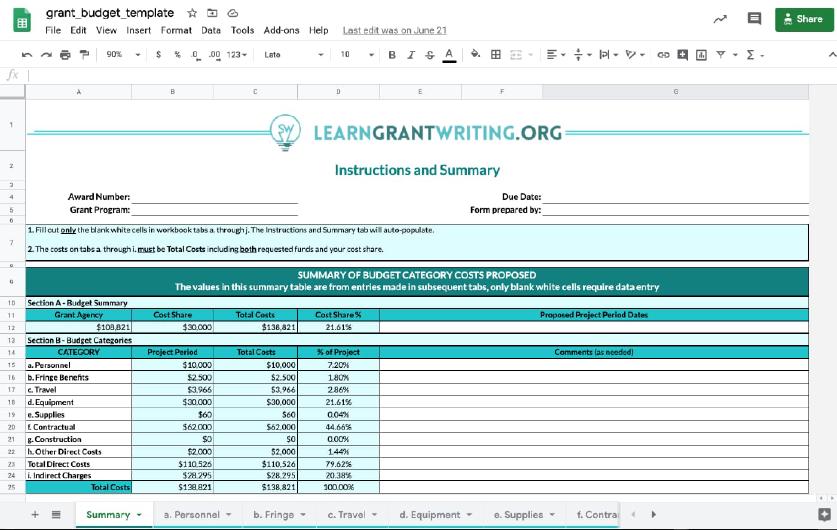
Step 5: Write Your Grant Narrative Fast and Furiously.
Now it’s time to put pen to paper (or, more likely, fingers to keys) and start writing your grant.
The grant narrative is a written description of your project, the problem it solves, and why it should be funded. It’s the bulk of your application, made up of the primary parts of a grant application listed above.
The exact nature of your narrative will vary depending on the requirements of each funding agency. Sometimes, a private foundation will ask for a letter of inquiry first. This is usually a two-page letter summarizing your proposal. If the funder likes your proposal, they’ll invite you to submit a full application. Other times, a grant narrative will be 15 pages of single-spaced writing with other lengthy and technical attachments.
Always customize your grant narrative to the grant for which you are applying. You can certainly recycle some text from previous applications, but it must be intentionally reworked to fit the funding guidelines.
Let’s take a look at some of our most important recommendations for this stage:
✏️ Prepare Your First Draft as Fast as Possible.
The time it takes to prepare your first draft of the narrative depends on the scope and complexity of the grant and its requirements.
If you are completing an online form, with responses generally under 500 characters, you should finish your first draft of the grant narrative in four days or fewer. If it’s a more complex proposal, requiring 18–20 pages of content, try to write your entire first draft in eight days (ideally fewer).
How do you write quickly? By staying focused.
It’s tempting to leave your narrative to track down information. At all costs, avoid doing this! Often the information you seek will get deleted in later drafts anyway, and it costs you too much time and energy to refocus.
For example, perhaps you are writing about who benefits from your project. It’s tempting to stop mid-sentence to look up supporting data. Instead, write a sentence like this: “XX% of the project beneficiaries are low to moderate income.” Later on, you can look up the exact statistic.
Let’s pause a hot second and talk about context switching. It is immensely taxing for your brain to bounce between tasks. With the best of intentions, we sit down to bust out our grant narrative. Not five minutes later we are glancing at our phone because notifications lit up on the screen, which somehow leads us to opening our inbox. Then we find ourselves ten tabs deep in our browser. It is crazy!
In fact, one study by Gloria Mark, Professor at the University of California Irvine’s Department of Informatics, found most people average only three minutes on any given task. Three minutes! When we context switch, it can eat up to 80% of our overall productivity , according to psychologist Gerald Weinberg.
Guess what? You will not be loving life as a grant writer if that is how you approach grant writing. This field requires deep work to A) get the job done, and B) keep you from burning out.
✏️ Write Your Grant Narrative Backward.
The harder sections are usually towards the end of your grant narrative and include topics like budgeting, project feasibility, etc. Working through the complex portions of the application first makes it easier to write the beginning sections, which are typically broader strokes.
⭐ Pro Tip: Dreading the idea of writing a long narrative?
Here’s a time-saving hack!
Record yourself talking slowly and clearly about each section of the narrative. Use your grant narrative skeleton
developed in Step 2 to guide your recording. Then use any number of online resources to convert your audio file
into text. The text file will be much easier to edit than writing your first draft from scratch. This method can
save hours of writing, and it is how I wrote the first edition of my book!
✏️ Stay Accountable by Collaborating With Someone Else.
When we spend a lot of time working on a narrative, we become blind to silly mistakes. Prevent errors and write faster by having someone else evaluate your grant writing progress.
Your “accountability buddy” does not need to read your earliest, messiest versions of the narrative. But, if you have them accepting your drafts, it keeps you accountable to writing deadlines. This support can be truly invaluable.
Send your progress every two to three days to inspire yourself to work quickly.
Identify who this person will be during the grant kick-off meeting. Ideally, it is someone within your organization. If you do not have someone in your organization to collaborate with, ask a friend or other working professional if you can repay them the favor later.
When I was just starting my business, I hired my sister to edit my grant narratives. She named her price by putting something she wanted in my Amazon cart, and I was happy to pay for it because of the mistakes that she caught!
✏️ Edit, Edit, and Edit Some More.
After you complete your first draft of the narrative, you want at least four more versions. That’s right, four. On complex grants, you can have as many as 15 different narrative drafts!
Remember, great writing is concise and clear. Winning grant proposals tell clear, impactful stories. The only way you get to that level of brevity and impact is to continually fine-tune the writing.
Step 6: Prep Your Key Grant Application Attachments.
You’re picking up great momentum now! You’ve read your funding guidelines, prepared your narrative skeleton, hosted a kick-off meeting, drafted a budget, and gotten underway with narrative writing.
A key part of learning how to write grants involves getting comfortable with a range of other documents and attachments. The attachments required for each application will vary depending on the grant program. In this section, we will cover the most common attachments you can expect to encounter: a budget and budget narrative, a resolution, and letters of support.
Attachments can require a long lead time to finalize, so it is important to start them early in the grant writing process. Generally, we advise discussing attachments at the progress meeting after your kick-off.
For a quick overview, watch this video about how to prepare common grant application attachments:
📃 Grant Budget and Budget Narrative
In Step 4, you developed your grant budget. We recommend you use our grant budget spreadsheet as your “base camp budget” for the general project as a whole.
Then, in this step, you’ll adapt your budget to the format specifically requested by the funder. Some might have you fill out the information via an online fillable form. Others will have their own spreadsheet for you to use.
This is where things can get confusing—budgets do not always have the same categories. If you get stuck, reach out to the funder for guidance.
Often the funder will also ask for a narrative to accompany your budget. What they’re looking for is a written description of how you arrived at the project cost. It’s extremely important to track that information when you initially create your budget and keep it documented in your project folder for easy reference.
We format budget narratives by using subheaders for each of the budget categories the funder includes. Be exhaustively detailed and thorough in your response.
📃 Resolution
A resolution is approval from the highest in command at your organization to submit a grant application. The purpose is to ensure that your organization is aware and willing to legally bind itself to the rules of the funding agency if awarded funds.
If you are a nonprofit organization with a board of directors, you would get a resolution passed by your board. If you are a government entity, your tribal or city council would approve the resolution. Resolutions are not always required for grants, and sometimes they will not be requested until later in the process.
In more complex federal grant applications, the funding guidelines may require very specific wording in the resolution. As always, follow your North Star (the funding guidelines!).
The timing for getting a resolution approved can be the tricky part. Most boards meet no more than once a month, which can make it challenging to get your resolution done and in their hands before the grant deadline. Be sure to figure out when your approving body meets and add that to your grant calendar so you won’t miss this deadline.
Coordinate with the Clerk or person responsible for preparing the board meeting to get your resolution on their agenda. Have the resolution printed on official letterhead. You’ll need the signed copy for your application.
📃 Letters of Support For Grants
Before awarding you funds, it’s common for foundations to want to see some references and third-party perspectives on your organization’s work and competencies. Great letters of support can play pivotal roles in the grant maker’s decision!
We have an entire blog post dedicated to helping you land compelling and vibrant letters of support—check it out!
Letters of Support
Want to double your narrative and not have to write it? The trick is great letters of support! Quality letters of support add heart and sincerity to your application and can nudge your application ahead of the rest.
Free Download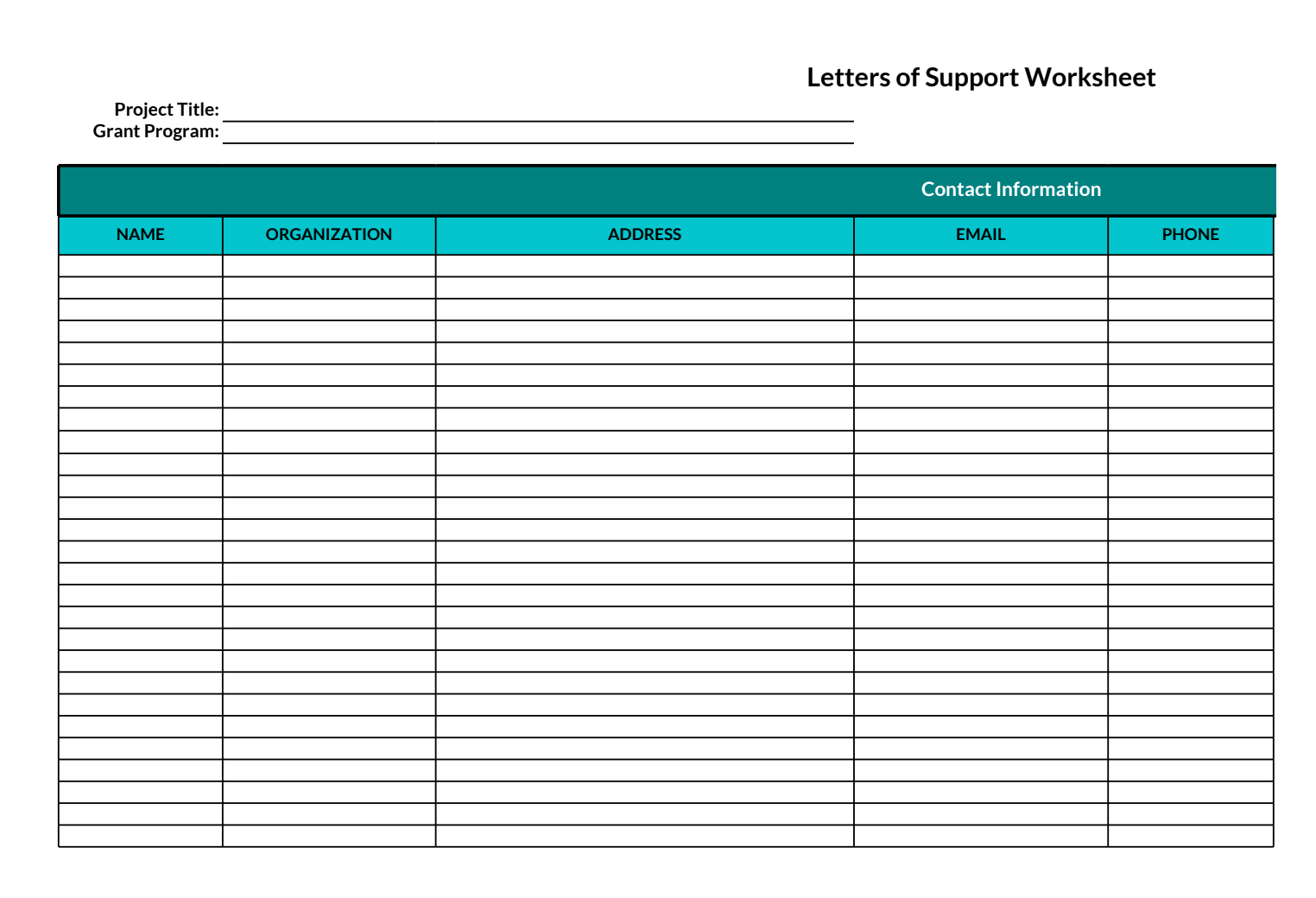
Finalizing Your Attachments
Once your attachments are complete, consider adding a cover sheet that describes what is included. This is particularly helpful for attachments with several documents like letters of support. You can list every organization that submitted a letter to make it easier for the reviewer to understand what they are about to read.
Free Grant Writing Class
Learn the 7-steps to write a winning grant application and amplify the impact you have on your community.
Access Free Class
Step 7: Conduct an Independent Review and Submit Your Grant!
Part of what makes grants so intimidating is the number of moving parts. You have the narrative, several attachments, the application submittal process, and more. Even if you are impeccably well organized, it can be easy to make a mistake. Avoid surprises of last-minute work by planning thoroughly at the beginning.
This is why project management is so important. At Learn Grant Writing, we use the Asana platform for project management, which makes tracking moving parts easy. Learn more about project management for grant writers with our guide.
Once you think you have completed everything in the application, package it as if you are going to submit it right then and there. But before submitting, give the application package to your independent reviewer.
Your reviewer will double-check that all forms are included and that your contact information is correct. It is usually the simple things where we find the most mistakes!
Now it’s time to submit your grant proposal. Turn in your application at least one day early, but preferably two. Most people are not managing their time well and submit their applications at the very last minute—don’t be that person. Avoid burnout, unnecessary stress, and embarrassing mistakes by submitting your grant early.
⭐ A word of advice from one grant writer to another:
You’ll experience a bizarre adrenaline rush after submitting your grant. There is something absolutely awful and wonderful about pressing send! If you followed the seven steps laid out here, you know the application was submitted in tip-top shape. But even then, it can give you nervous energy.
Have a plan to dissipate this energy. Take the afternoon off and go for a hike. Meet up with a friend. Take a bike ride. Doing something active is the best way to diffuse any lingering grant writing intensity while also helping celebrate the successful submission with “you time.”
Want more tips for a smooth grant submission process? We’ve got ‘em. Check out this video!
How to Learn Grant Writing - We Can Help!
You now know the seven steps to write a grant! The trick to being a Grant Writing Unicorn is not having magical superpowers, but simply following the funding guidelines to a tee, being the best project manager you can be, and learning to manage your focus.
Mastering those principles will make you an unstoppable grant writing force.
If you want more thorough training, we can help! Join our free grant writing course for a more in-depth look at our grant writing process, plus tons of extra tips.
And for the complete grant writing experience, consider joining the Global Grant Writers Collective. This membership program gives you everything—a professional-grade (but always accessible) grant writing curriculum, coaching, mentorship, community with other grant writers, and even CFRE grant writing certification!
Our Unicorns have used their experiences with the Collective to secure more funding for their nonprofits, start lucrative new side hustles, and even launch fulfilling new careers as grant writing consultants— check out some of their stories!
But whatever you do, keep learning! Here are a few resources we recommend as you get started on your grant writing journey:
- The Best Online Grant Writing Classes for Every Learner
- How to Become a Freelance Grant Writer
- Tips for Writing Your First Draft of a Grant Narrative
- How to Avoid Last-Minute Grant Pursuits
Happy grant writing!🦄
Free Grant Writing Class
Learn the 7-steps to write a winning grant application and amplify the impact you have on your community.
Access Free Class

